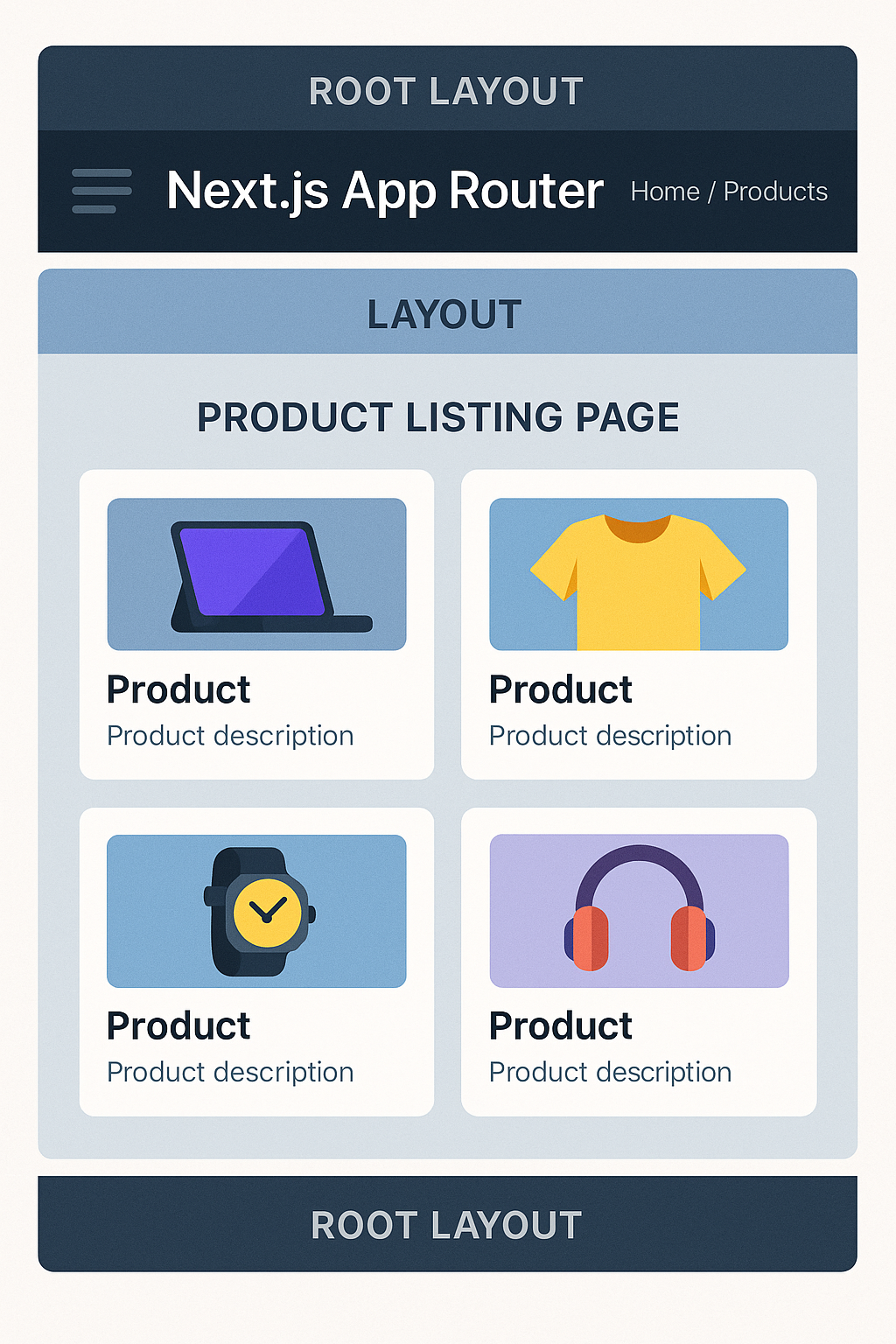
The Next.js App Router introduces a powerful and intuitive strategy for handling nested layouts, unlocking flexible pattern design for pages like a Product Listing Page (PLP) in modern e-commerce or catalogue applications. This approach makes it simpler to share layout components (such as sidebars, filters, breadcrumbs, and persistent navigation) across specific sections of your site while keeping code organized and maintainable[1][3][5].
Core Principles of Next.js App Router Layouts
- File-system based routing: The folder structure under the
/appdirectory directly maps to the route hierarchy. - Colocation: UI logic and layout files are stored close to their relevant routes and pages, making code easier to reason about and maintain[3].
- Partial rendering: Only the parts of the UI that change as users navigate are re-rendered, while stable layouts persist across nested routes.
Implementing a Nested Layout Strategy for a Product Listing Page
1. Folder and File Structure
A typical product domain might have routes for:
- Viewing all products
- Seeing products by category
- Product details
- Product reviews
This maps naturally to nested folders in /app:
/app
/products
layout.tsx ← Product section layout (filters, sidebar)
page.tsx ← Product listing (all products)
/[category]
page.tsx ← Product listing (filtered by category)
/[productId]
layout.tsx ← Product detail layout (tabs, header)
page.tsx ← Product details
/reviews
page.tsx ← Product reviews
2. Root Layout
At the very top, the root layout.tsx (usually under /app/layout.tsx) defines your site-wide UI: header, footer, and navigation bar[1].
// /app/layout.tsx
export default function RootLayout({ children }) {
return (
<>
<Header />
<main>{children}</main>
<Footer />
</>
);
}
[1]
3. Product Section Layout
This wraps all /products routes, allowing you to provide consistent components like category lists or filter panels:
// /app/products/layout.tsx
export default function ProductsLayout({ children }) {
return (
<div className="products-layout">
<SidebarFilters />
<section className="products-content">{children}</section>
</div>
);
}
[2][5]
- Only content inside
<section className="products-content">will change as the user navigates within the products area; the filters/sidebar persist.
4. Nested Layouts for Detail Views
Suppose you want a different layout when displaying an individual product (with tabs for "Details", "Reviews", etc.):
// /app/products/[productId]/layout.tsx
export default function ProductDetailLayout({ children }) {
return (
<div>
<ProductHeader />
<ProductTabs />
<section>{children}</section>
</div>
);
}
[5]
- Visiting
/products/123renders the product details in<section>. - Visiting
/products/123/reviewsrenders product reviews—all while keeping the same header and tab navigation.
Using Dynamic Route Segments
Dynamic routes such as /products/[category] or /products/[productId] allow you to render category-based lists or specific product pages, respectively[4]. File names in square brackets denote dynamic parameters, making the system robust for deeply nested listings and detail pages.
Benefits of This Strategy
- Separation of concerns: Layout logic is localized to the relevant parts of the route tree.
- Persistent UI state: Filters, navigation, and other controls do not remount as users browse within product lists or categories.
- Performance: Only the necessary components re-render on navigation (partial rendering).
- Clarity: Clear mapping from URL structure to file/folder structure helps teams quickly navigate and extend the codebase[3][5].
Example: Navigating the Product Listing Flow
| URL | Layout Hierarchy |
|---|---|
/products |
RootLayout → ProductsLayout → Product Listing Page |
/products/shoes |
RootLayout → ProductsLayout → Category Page ("shoes") |
/products/123 |
RootLayout → ProductsLayout → ProductDetailLayout → Product Detail Page |
/products/123/reviews/1 |
RootLayout → ProductsLayout → ProductDetailLayout → ReviewsPage (review for product) |
Important Considerations
- Each
layout.tsxpersists for its segment (and child segments) unless a lower-level layout is defined[5]. - You cannot nest multiple layouts for the same route segment—there's only one active layout per segment hierarchy[5].
- Global state shared across all layouts should be placed at the highest relevant layout level.
Caveats and Limitations
- Changes to a parent layout (e.g.,
/products/layout.tsx) will cause a full refresh of children, as the layout is re-evaluated down the tree. - Over-nesting layouts can complicate debugging and state management—design your layout hierarchy to balance separation and simplicity[1].
Conclusion
The App Router’s nested layout strategy provides structure, performance, and maintainability for complex interfaces like product listing pages, supporting deeply nested use-cases and shared UI scenarios with minimal boilerplate[2][3][5]. This design unlocks scalable, modular, and high-performance e-commerce projects in Next.js.
No comments:
Post a Comment